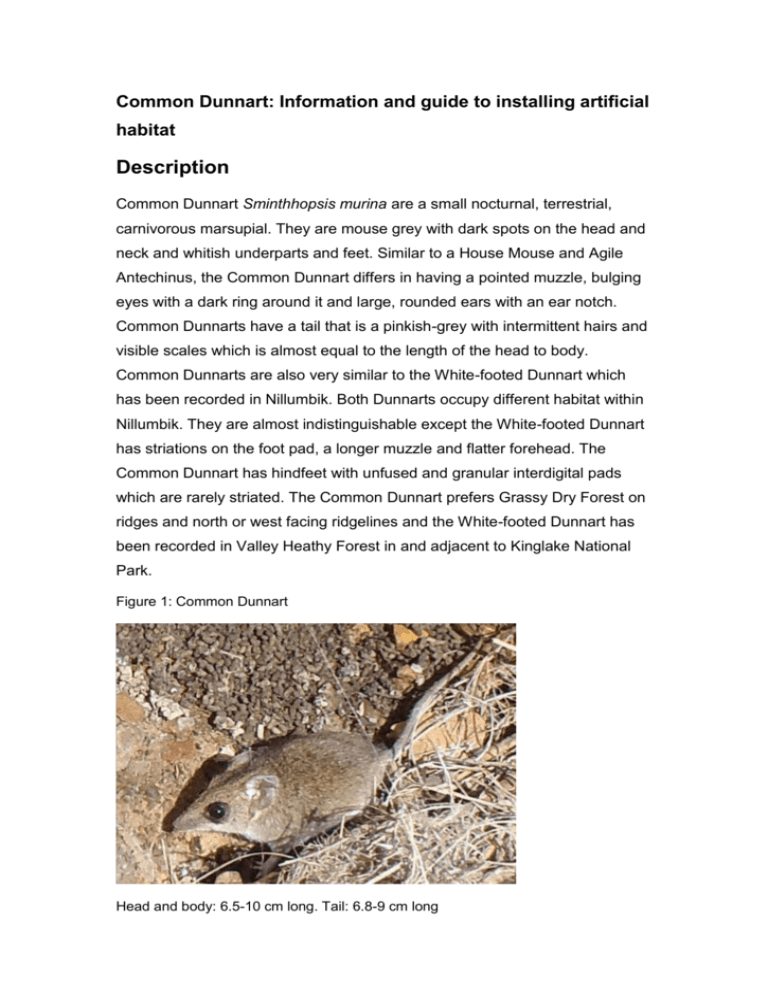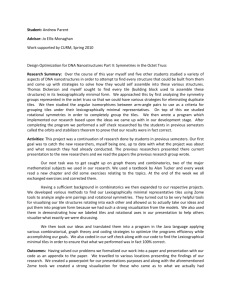Common Dunnart installing artificial habitat
advertisement

Common Dunnart: Information and guide to installing artificial habitat Description Common Dunnart Sminthhopsis murina are a small nocturnal, terrestrial, carnivorous marsupial. They are mouse grey with dark spots on the head and neck and whitish underparts and feet. Similar to a House Mouse and Agile Antechinus, the Common Dunnart differs in having a pointed muzzle, bulging eyes with a dark ring around it and large, rounded ears with an ear notch. Common Dunnarts have a tail that is a pinkish-grey with intermittent hairs and visible scales which is almost equal to the length of the head to body. Common Dunnarts are also very similar to the White-footed Dunnart which has been recorded in Nillumbik. Both Dunnarts occupy different habitat within Nillumbik. They are almost indistinguishable except the White-footed Dunnart has striations on the foot pad, a longer muzzle and flatter forehead. The Common Dunnart has hindfeet with unfused and granular interdigital pads which are rarely striated. The Common Dunnart prefers Grassy Dry Forest on ridges and north or west facing ridgelines and the White-footed Dunnart has been recorded in Valley Heathy Forest in and adjacent to Kinglake National Park. Figure 1: Common Dunnart Head and body: 6.5-10 cm long. Tail: 6.8-9 cm long Figure 2: House Mouse. Distinct musty odour, lacks deep ear notch, tail is virtually naked with clear rings of scales and is longer than head-body. Head and body: 6-9cm long. Tail: 7.5-9 cm long Figure 3: Agile Antechinus: Slightly larger, darker grey body, no eye ring. Head and body: 8-11.6cm long. Tail: 7.5-10.2cm long Figure 4: Examples of Grassy Dry Forest habitat occupied by Common Dunnart in Christmas Hills It has been observed that they usually prefer areas with an open shrub cover less than 20 per cent and a dense understorey cover of grasses with greater than 50% cover (Beardsell pers. comm.). Vegetation structure of an area tends to be more important for small mammals rather than vegetation composition and as such the Common Dunnart tends to prefer microhabitats that are more structurally complex. Red-anther Wallaby Grass is very important for this species as it provides habitat and cover for it. The presence of logs and rock crevices/embedded rock is also shown to be of more importance than trees and understorey composition in reducing the risk of predation (Stokes et al. 2004). When these elements are missing in their habitat it is possible to introduce artificial habitat, such as pavers or roof tiles, to replace it in the short term. Ecology Individuals have been recorded keeping several daytime refuges and they can forage over several hectares each night (Paull 2013). During winter periods they can stop being surface active due to the cold weather. They have also been recorded entering periods of torpor or reduced metabolic activity over autumn/winter in response to low temperatures and reduced food availability (Paull 2013). Their diet consists of a wide range of insects and spiders. According to Fox and Archer 1984, they are not opportunistic feeders and tend to prefer scarabs, beetles, roaches, moths and larvae in spring/summer whilst favouring spiders in autumn/winter. During the day, the Common Dunnart has been known to rest in cup-shaped nests from 70-110mm wide consisting of dried grasses and leaves built into log hollows, grass clumps, or rock crevices (Fox 1995). According to Menkhorst and Knight 2011 they can breed twice a year between August to March, producing 8 to 10 young. However, local observations have only detected one breeding cycle per year between August to October and this may possibly be due to the temperate climate which might not allow for a second breeding cycle. In later stages of nursing only 4-5 young are observed in their litter in temperate areas. Following breeding the males die and are seldom observed after September. Females raise the young for about 65 days from October to November and in December the young are weaned and become independent (Menkhorst and Knight 2011). Juveniles reach full adult size after 150 days. Adult females die not long after the juveniles become independent and they usually aren’t observed after January. The best time to observe Common Dunnarts is from September to April as this is when they are most active. However, be aware that females might be carrying pouch young so it is best not to handle them. Handling females with pouch young can cause undue stress to the animal. If you have an approved wildlife permit from the Department of Environment and Primary Industries and animal ethics approval you may be given approval to handle them for scientific purposes. Fire Ecology beneficial to Common Dunnarts According to observations of a population of Common Dunnarts in One Tree Hill reserve, it was noted that Common Dunnarts are good colonises of mid-succession fires. Observations following a fire in this reserve found that not much had changed with the structure of the vegetation after two years after fire and Common Dunnarts were not observed. However, 3-4 years after the fire, the structure of the vegetation began to alter and there was a large spike in the population numbers. After 8-9 years the population dropped back or were more difficult to observe. Therefore, it is believed that the ideal time to observe Common Dunnarts can be 3-8 years after fire. This trend in population fluctuation tends to correlate with the minimum TFIs for Grassy/Heathy Dry Forest as indicated below and supports the idea that the structure of the vegetation is important for this species with the ideal vegetation structure being between 3-8 years after a fire. It is to be noted that a mosaic burn was implemented in this area to ensure there was habitat remaining for the species while the burnt area regenerated. When considering an ecological burn it is important to consider keeping some unburnt vegetation in order to provide food and areas of shelter that the animals can retreat to while the vegetation cover returns in the burn site. The minimum patch-burning cycle for Grassy and Heathy Dry Forest habitat should be 10-15 years (Cheal, 2010). An ideal time to undertake an ecological burn in an area of suitable habitat is in autumn once the breeding cycle is complete. It is not an ideal time to undertake a burn in spring as Common Dunnarts will be breeding. Well planned ecological burning in appropriate areas may also encourage the colonisation of a site by the Common Dunnart. However, other species that might also occupy the same habitat should be considered when planning to undertake an ecological burn. This can include, but is not limited to, orchid species and other mammals such as the Brush-tailed Phascogale. The minimum and maximum tolerable fire intervals predicted for Grassy/Heathy Dry Forest is shown in the table below and has been taken from the Growth Stages and Tolerable Fire Intervals (TFI) for Victoria's Native Vegetation Data Sets Report 84 (Cheal, 2010). EVD name Max. TFI (years) Minimum TFI – Minimum TFI – high-intensity low-intensity fires (years) patchy burns (years) Grassy/Heathy Dry 45 15 10 Forest Installing Artificial Habitat - ‘Dunnart Tiles’ Prior to installing tiles check with the Department of Environment and Primary Industries to see if you need a wildlife permit and animal ethics approval. Concrete tiles or pavers can be used to help identify if Common Dunnarts are in the area or to help determine population size. They can also be used to supplement or create artificial habitat if it is lacking. In particular, installing tiles after an ecological burn or fire event can help to provide habitat for Dunnarts for up to 8 or 9 years after fire. In suitable habitat it is appropriate to set up tiles after an ecological burn or bushfire to help detect if the species is occupying the area or to help provide shelter and habitat for existing populations. If concrete tiles or pavers are installed and Common Dunnarts are found occupying them, a management program should be implemented. This may include habitat enhancement by introducing logs, undertaking fox, cat and exotic rodent control, undertaking weed control, protecting or fencing habitat from predators, applying ecological burning and increasing plant diversity to attract prey and create shelter. Tiles and installation Tiles should be heavy concrete tiles/pavers (minimum size 40 x 40 x 3 cm) or 2 roof tiles that are weighed down (minimum size of each roof tile 40 x 25 cm). If the roof tiles are not heavy or weighed down it is possible that they can be flipped over by predators such as foxes and this can risk an increase in predation. Figure 5: A concrete paver used to supplement habitat for a Common Dunnart Ventilation is very important and tiles need to have adequate drainage underneath in order to deter the growth of mould and fungi. Placing a layer of river pebbles or gravel underneath will help with ventilation and stop any dampness. However, don’t let the layer be so high as to allow snakes to use it. As the tiles are usually used by Dunnarts during their reproductive season a small depression or hollow will need to be left in the pebbles for nesting. If the tiles are set up on a flat or low surface, drainage channels will need to be set up around the paver to reduce the risk of flooding during heavy rains. To provide protection from predators, a 1.5m high predator proof fence can be erected around the tiles. In areas that are or have been heavily grazed, herbivore exclusion or rabbit proof fences should be installed to help the vegetation cover to return and the grass cover to increase as this will help to reduce the risk of predation. It will also allow any burnt vegetation to recover quicker. If you are installing predator proof fencing around a burnt area, where possible try to include about 10% of unburnt vegetation within the fencing as this will provide the Dunnarts with some additional protection while they are foraging in these unburnt areas. Other things can also be reintroduced as habitat such as hollow logs. When installing and inspecting/monitoring the tiles the following information should be collected: The location of each tile recorded using a GPS or marked up on a mud map/aerial photo; date of set up; date of inspection and the name of the observer; photos of the site and, where possible, a photo of any animal observed under the tile; if the tile is occupied or not; a count of observed individuals under each tile and the species observed. Appendix 1 displays an example data recording sheet. All vertebrates found sheltering under the tiles should be recorded and where possible submitted into the Victorian Biodiversity Atlas. Any invertebrates should be noted and the tile moved if ants have occupied the area. Risks and Mitigation There is a risk of foxes and cats quickly learning that Common Dunnarts reside underneath tiles and once they learn this there is an increased risk of predation. Observations have been made of foxes marking occupied tiles and turning them over if they are not heavy enough. This risk can be averted by placing a heavy log or rock on top of a light tile, undertaking fox or cat control, fencing off the area with predatorproof fences, introducing habitat refuges such as logs, increasing vegetation cover, particularly Red-anther Wallaby Grass or Poa sp., and/or retaining embedded rocks that the Dunnarts can retreat to. Know when to look and when not to look under the tiles to avoid any stress to the animals. Between October and April are the prime times to observe Common Dunnarts under tiles as this is when they are most active. Try to avoid looking under tiles around August to October as they have pouch young and observation may cause some distress. However, provided you do not handle the Dunnarts this distress may be minimal. It is highly advisable to wear gloves when checking tiles. When checking and lifting tiles be very careful as you may encounter venomous animals that might be living under them such as snakes, spiders and ants. For example, the Eastern Small-eyed Snake, a small, locally rare, but venomous snake can sometimes reside under the tiles as well as Redback Spiders and Jumping Jacks. Any ants that occupy the space under a tile will deter a Dunnart from occupying it. If numerous ants or an ant’s nest are observed under the tile you should move the tile at least 50cm away so it can again become a shelter for a Dunnart. If it is occupied by another animal such as a reptile then leave the tile in place. Please note that under the Wildlife Act 1975 it is an offence to possess, harass, injure or kill any native wildlife and this include snakes. Regular maintenance is also required under tiles that are left in place for a number of years. Moving the tile if it is occupied by ants and making sure the area under the tile is dry will help to deter dampness which can result in the growth of mould and fungi. This maintenance will help to increase the chance of Dunnarts sheltering under the tile. References Beardsell, C. 1997. Sites of faunal and habitat significance in North East Melbourne. Nillumbik Shire Council, Greensborough. Cheal 2010. Growth stages and tolerable fire intervals for Victoria's native vegetation data sets Report 84. Arthur Rylah Institute, Heidelberg. Fox, B.J., Whitford, D. 1982. Polyoestry in a predictable coastal environment: Reproduction, Growth and Development in Sminthopsis murina (Dasyuridae, marsupialia). Carnivorous Marsupials. Royal Zoological Society of New South Wales. Sydney. pp. 39-48. Fox, B.J., Archer, E. 1984. The diets of Sminthopsis murina and Antechinus stuartii (Marsupialia:Dasyuridae) in Sympatry. Australian Wildlife Resources 11:235-248. Fox B. J. 1995. Common dunnart, Sminthopsis murina. In: The Mammals of Australia (ed. R. Strahan). The Australian Museum Trust, New Holland Publishers, Sydney. pp. 150–1 Menkhorst, P.W., Knight, F. 2004. A Field Guide to the Mammals of Australia. Oxford University Press. Melbourne. pp70-71. Morton, S.R., Wainer, J.W., Thwaites, T.P. 1980. Distribution and habitats of Sminthopsis leucopus and S. murina (Marsupialia: Dasyuridae) in southeastern Australia. Australian Mammalogy. 3: pp19-30. Paull, D.C. 2013 Refuge sites, activity and torpor in wild common dunnarts (Sminthopsis murina) in a temperate heathland. Australian Mammalogy 35(2):153-159 Stokes, V.L., Pech, R.P., Banks, P., Arthur, A.D. 2004. Foraging behaviour and habitat use by Antechinus flavipes and Sminthopsis murina (Marsupialia: Dasyuridae) in response to predation risk in eucalypt woodland. Biological Conservation 117:331-342. Appendix 1: Example Data Recording Sheet Recorded by: A Person Date: 11/04/14 Camera: Nikon Coolpix GPS: Garmin Map 62 Tile number 1 GPS location Latitude -37.646859 GPS Location Longtitude 145.251617 Occupied? Species observed Number of individuals Photo number Notes Yes Common Dunnart 2 005 Nest has been built







